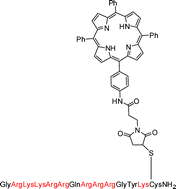Effective photoinactivation of Gram-positive and Gram-negative bacterial strains using an HIV-1 Tat peptide–porphyrin conjugate
Abstract
Given that

* Corresponding authors
a National Medical Laser Centre, Division of Surgery and Interventional Science, UCL Medical School, University College London, Charles Bell House, 67-73 Riding House St, London, UK
b Department of Pharmacy and Pharmacology, University of Bath, Claverton Down, Bath, UK
c
Division of Microbial Diseases, UCL Eastman Dental Institute, University College London, 256 Grays Inn Road, London, UK
E-mail:
M.Wilson@eastman.ucl.ac.uk
Fax: +44 (0) 20 7915 1127
Tel: +44 (0) 20 7915 1050
Given that

 Please wait while we load your content...
Something went wrong. Try again?
Please wait while we load your content...
Something went wrong. Try again?
L. Bourré, F. Giuntini, I. M. Eggleston, C. A. Mosse, A. J. MacRobert and M. Wilson, Photochem. Photobiol. Sci., 2010, 9, 1613 DOI: 10.1039/C0PP00146E
To request permission to reproduce material from this article, please go to the Copyright Clearance Center request page.
If you are an author contributing to an RSC publication, you do not need to request permission provided correct acknowledgement is given.
If you are the author of this article, you do not need to request permission to reproduce figures and diagrams provided correct acknowledgement is given. If you want to reproduce the whole article in a third-party publication (excluding your thesis/dissertation for which permission is not required) please go to the Copyright Clearance Center request page.
Read more about how to correctly acknowledge RSC content.
 Fetching data from CrossRef.
Fetching data from CrossRef.
This may take some time to load.
Loading related content
